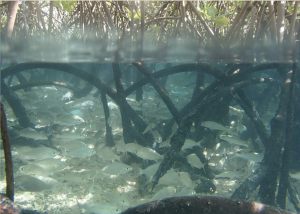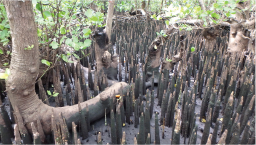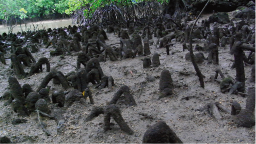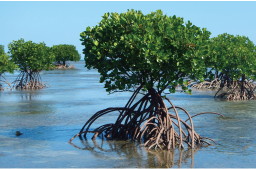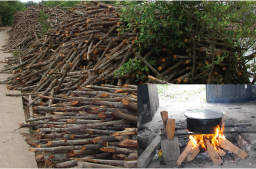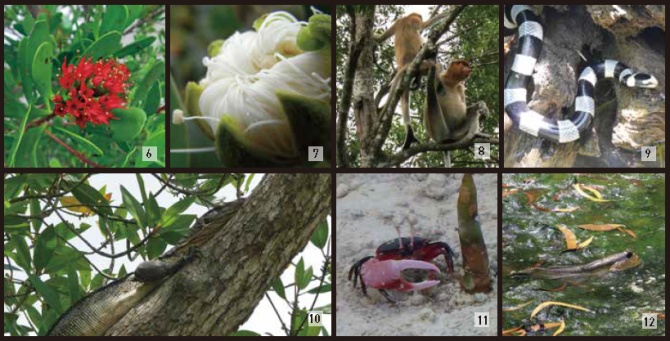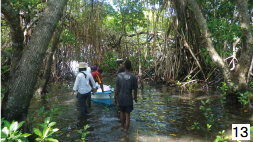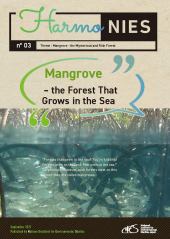HarmoNIES No.3
Mangrove - the Mysterious and Rich Forest
Mangrove
- the Forest That Grows in the Sea
“Forests that grow in the sea? You’re kidding! Forests grow on the land. Fish swim in the sea.”
Surprisingly, however, such forests exist on this planet: they are called mangroves.
Keywords: aerial root, bacterium, ecosystem function, mangrove plant, tidal flat, tropical/subtropical
"We can liken this to a circus performer juggling and playing a pantomime, all while balancing on a ball. "
Mystery of Mangrove
Mangrove forests grow in tidal estuaries in the tropics and subtropics.
Mangrove tree roots
Gifted Roots
Furthermore, she continues, mangrove trees work 24 hours a day to prevent salt intake from the sea water. Some roots filter out the salts, others excrete it. This is amazing and must require a lot of energy.
Mangrove roots are thus gifted. They work hard to keep the trees upright in the soft soil and moving water, breathe air above the water, and keep shunting salt out, which is energy-intensive work. We can liken this to a circus performer juggling and playing a pantomime, all while balancing on a ball.
Living in Harmony with Rich Mangrove Forests
Future Research on Mangroves
Dr. Inoue hopes to develop her research to be able to listen to the “voices” of mangroves, and relay their message to people to foster better relations between mangroves and other living things, particularly humans, which all depend on mangroves. I cannot take my eyes away from the mangroves.
Ecosystem in Mangrove Forests
A wide range of living creatures are living in mangrove forests. These photos are just a few example.
Photo 6: Lumnitzera littorea, Kiribati
Photo 7: Sonneratia alba, Iriomote Japan
Photo 8: Proboscis monkeys, Malaysia
Photo 9: Sea snake, Fiji
Photo 10: Monitor lizard, Malaysia
Photo 11: Fiddler crab, Fiji
Photo 12: Mud skipper, Viet Nam
Tropical Coastal Ecosystem Portal
The information would contribute to a deepened understanding of tropical coastal ecosystems.
URL:http://www.nies.go.jp/TroCEP/index.html
Related Papers
- Inoue T., Shimono A., Akajji Y., Baba S., Takenaka A., Chan H. T. (2020) Mangrove-diazotroph relationships at the root, tree and forest scales: diazotrophic communities creates high soil nitrogenase activities in Rhizophora stylosa rhizospheres. Annals of Botany, 125(1), 131-144.
- Inoue T., Khozu A., Shimono A. (2019) Tracking the route of atmospheric nitrogen to diazotrophs colonizing buried mangrove roots. Tree Physiology, 39(11), 1896-1906.
- Inoue T. (2018) Carbon Sequestration in Mangroves Kuwae T. and Hori M. eds Blue carbon in Shallow Coastal Ecosystems: Carbon Dynamics, Policy, and Implementation, Springer, pp.373
Coverphoto: International Society for Mangrove Ecosystems (ISME), Photo 1-9,11-12: Tomomi Inoue, 10: Mami Kainuma, 13: Hiroshi Adachi
Download PDF
Inquiry
International Coordination Office, Planning Division
National Institute for Environmental Studies
16-2 Onogawa, Tsukuba, Ibaraki 305-8506, Japan
e-mail: int-pub{a}nies.go.jp

